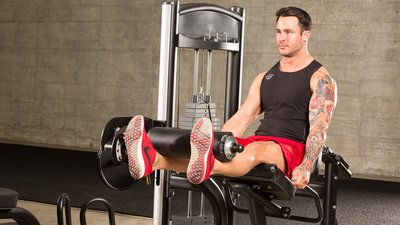Training with near-maximal loads can be one of the best ways to get big, gain strength, and protect your body against injury—but only if you load the right exercises heavy.
Don't leave your results or orthopedic health to chance—or to the whims of your ego. Stop going heavy on these four moves, and swap them out for our healthier alternatives. You'll build strength and muscle without leaving your joints in shambles in the process.
1. The Barbell Overhead Press
If you want to instantly identify an athlete's weak link, the heavy barbell overhead press is about as perfect a diagnostic you could hope for. Why? A safe, heavy traditional press demands:
- Synergistic coordination of tension and stability throughout the entire body.
- Adequate mobility to express power in the vertical plane of motion, where many athletes are severely limited.
- Technique that holds up while using perhaps the most unforgiving loading tool in the iron game, the barbell.
After assessing more than enough faulty overhead presses in my career, it's clear that the usual trainee's combination of poor posture and even poorer stability throughout the spine and pelvis make this specific exercise very difficult to train pain-free. And this is especially true as the loads climb and weak links become more exacerbated.
If you truly want to own the overhead position, train it hard, but load it intelligently—which probably means lighter than you think. If you can't help but flare your lower back or crank on your shoulders during the military press, use a smarter pressing variation that is both safe and effective.
Do This Instead: Scrape-the-Rack Press
The anterior deltoids tend to respond favorably to power- and strength-based loading schemes. But the first of those options often gets overlooked. In other words, rather than always adding weight to the bar, you can increase force by moving a load with more speed and acceleration.
The scrape-the-rack press is a powerful overhead training tool for power, strength, and physique athletes. It places your lower body in a strong, stable split stance and allows you to use physics to enhance the training effect without adding more poundage to the bar. By placing the barbell in contact with the rack and squeezing it into the rack hard throughout the press, you not only increase the friction between the bar and rack, you enhance shoulder and spinal stability.
In combination with the friction, executing this press as explosively as possible against light loading stimulates the recruitment of fast-twitch motor units, which is exactly what we want out of an anterior shoulder exercise variation. Stick with 5-8 quality reps per set with explosive bar speed, and focus on nailing the peak contraction at the top of each and every rep.
2. Leg-Extension Machine
Rehab pros all over the world have been bitching and moaning about how the leg-extension machine is largely to blame for the knee-pain epidemic among the lifting population. But respectfully, I think that this claim is bullshit, as there have been some great strength and aesthetic improvements among my athletes using this machine intelligently. That usually means not loading it to the gills and trying to hit triples with the entire stack loaded up.
The leg extension has what's known as an open kinematic chain, with your feet moving freely through space. This type of movement has to be approached with a bit more caution than closed-chain movements, where your feet are in contact with the ground, because it demands more from your joints.
Despite what some people will tell you, open-chain movements aren't inherently bad by any means. They just fit more ideally with pump-based exercises that enhance the activation, feel, and metabolic stress of a movement, rather than the ability to throw around maximal loads for a few reps.
As anyone who has ever let ego drive up the weights on the leg-extension machine knows, the more the load is increased, the more stress seems to travel directly to the sub-patellar space under the knee caps. We call this "compensating with the joints instead of targeting the muscles," and this is exactly what we don't want out of a movement that is predominantly used to spark hypertrophy in a lagging region.
While you don't have to throw this machine away completely, there are better ways to use it to achieve a superior muscle-building response, minus the achy knees afterward.
Do This Instead: Metabolic-Stress Leg Extensions
You can think of metabolic stress as eliciting a nasty pump that rushes localized blood into the active muscles and hurts like hell—in a good way, of course. These three programming tools will require you to really tap into your mind-muscle connection while battling through the pump:
- Keep constant tension through the muscular movers.
- Use high-volume set and rep schemes of 15-50 reps per set
- Create cumulative fatigue from decreasing rest periods between sets.
If you want to take the leg-extension machine to the next level, try adding blood flow restriction cuffs to your legs and cranking out high-rep sets with lighter weights and short rest periods. By applying specialty cuffs, regular rubber resistance bands, or even knee wraps to your upper legs near your gluteal folds in back and your hip creases in front, you can trap blood flow in the tissues without letting it go back into central circulation.
For this method, be mindful of the cuff tightness, keeping it no tighter than about a 7 out of 10, and be very conservative with loads. You can get a killer training effect using 30-40 percent of your 1RM for the leg extension, and there's no benefit in going much heavier. That right there is the exact reason why BFR leg extensions are a smart addition to your leg day.

3. The Leg Press
Many of us have become jaded about the leg press because of the utter nonsense that fills our Instagram feeds. Don't know what I'm talking about? Picture every single 45-pound plate in the gym stacked on top of the leg-press machine, plus a few human beings, all carefully arranged for some half-wit to manage 3 reps with 2 inches of range of motion. You know you've seen it. Maybe you've done it yourself!
Though this is an insane extreme, the reasons for loading the leg press heavy crumble once you look at the risk-to-benefit breakdown.
Let's start with the seated position. Sitting while training is less than ideal, no matter the movement. We sit all damn day, so the last thing we need to do is sit even more while we train, especially under a heavy load. But the seated position on a 45-degree angle leg-press machine—by far the most common in gym settings—is particularly problematic once you combine a heavy load, deep hip flexion, and the knees being forced into the chest.
As the knees get close to the chest, the spine is forced into a lumbar flexed position, which isn't ideal for heavy loading. In order to press out of the end-range position, the spine then moves into extension, which again is more unwanted movement coming from the lower back. To cap it off, the pelvis will also create unwanted movement in the form of posterior and anterior tilting, which can further exacerbate those risky spinal positions.
So how do you avoid this dilemma? Simply avoid excessive loading on this machine and instead train it in higher rep ranges, with more of a pump mindset. Even better, you can combine it with pre-exhaust superset techniques that fatigue the glutes, allowing you to isolate the quadriceps without the need to pile on plates.
Do This Instead: Pre-Fatigued, High-Rep Leg Press
I've seen huge results from this pain-free superset, including with athletes and clients who have otherwise avoided the leg-press machine like the plague. It's become a staple in my programming and fits in perfectly as a mentally and physically challenging finisher on the tail-end of any lower-body-emphasis day.
The first movement in the pairing will be the double-banded hip thrust. As the name implies, you set up one longer mini band over your hips to resist extension and place a second shorter band around your knees to keep your hips from moving into abduction and external rotation, which are two commonly neglected actions of the gluteal group.
The goal here is to pump the glutes as hard as you can, with smooth constant tension reps up and down, peaking the contractions at the top of every rep. Never pause throughout the set. This will be a mental test for you, as it requires you to maintain movement quality through 20-50 reps. When you can no longer complete quality contractions at the glutes, stand up and move right into the leg-press machine.
At this point, I want your ass to be on fire and your heart rate elevated. This will ensure that your submaximal loads on the machine create a devastating but risk-free training effect. Get into position on the machine and ensure that your butt is solid on the pad, your back stays flat against the back of the pad, and your core remains braced throughout. While monitoring the range of motion of your knees to your chest, crank out 15-30 constant tension reps that keep the quality of the movement up. No ugly grinding here.
When you can no longer complete good reps on the leg-press machine, rest 90-120 seconds, then start your hip thrusts again. Work to complete 2-5 rounds of this. I promise you that both the muscular and systemic effect of this superset will far outweigh those of the heavy leg pressing any day, and you'll avoid lower-back pain in the process.

